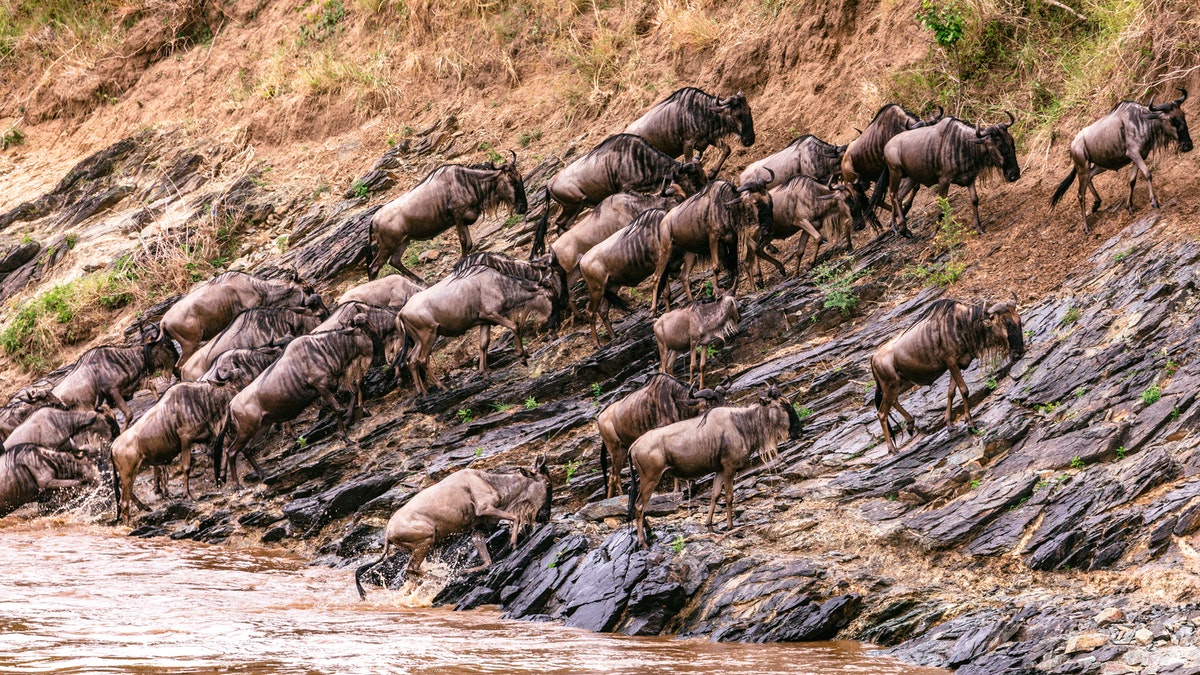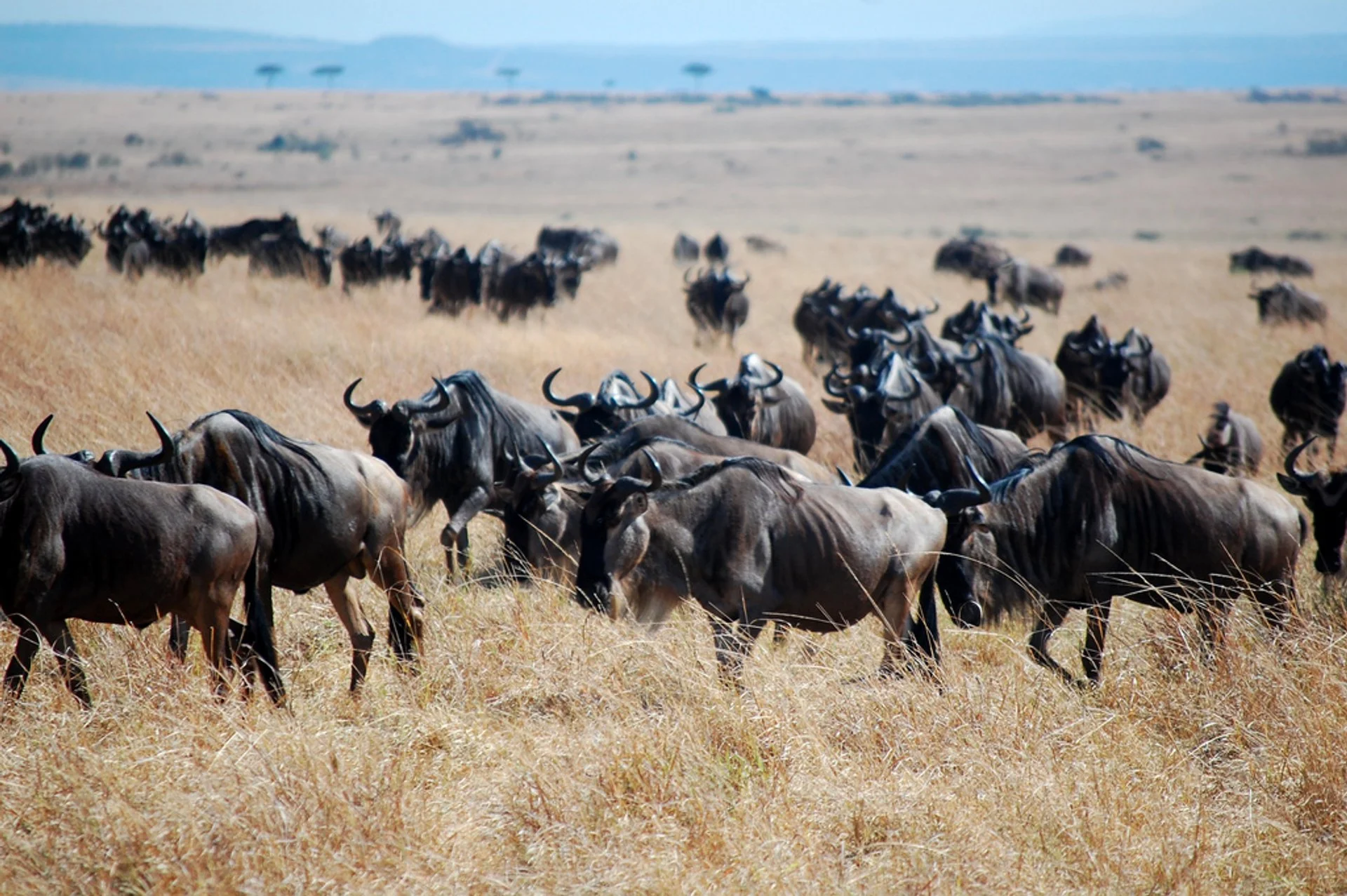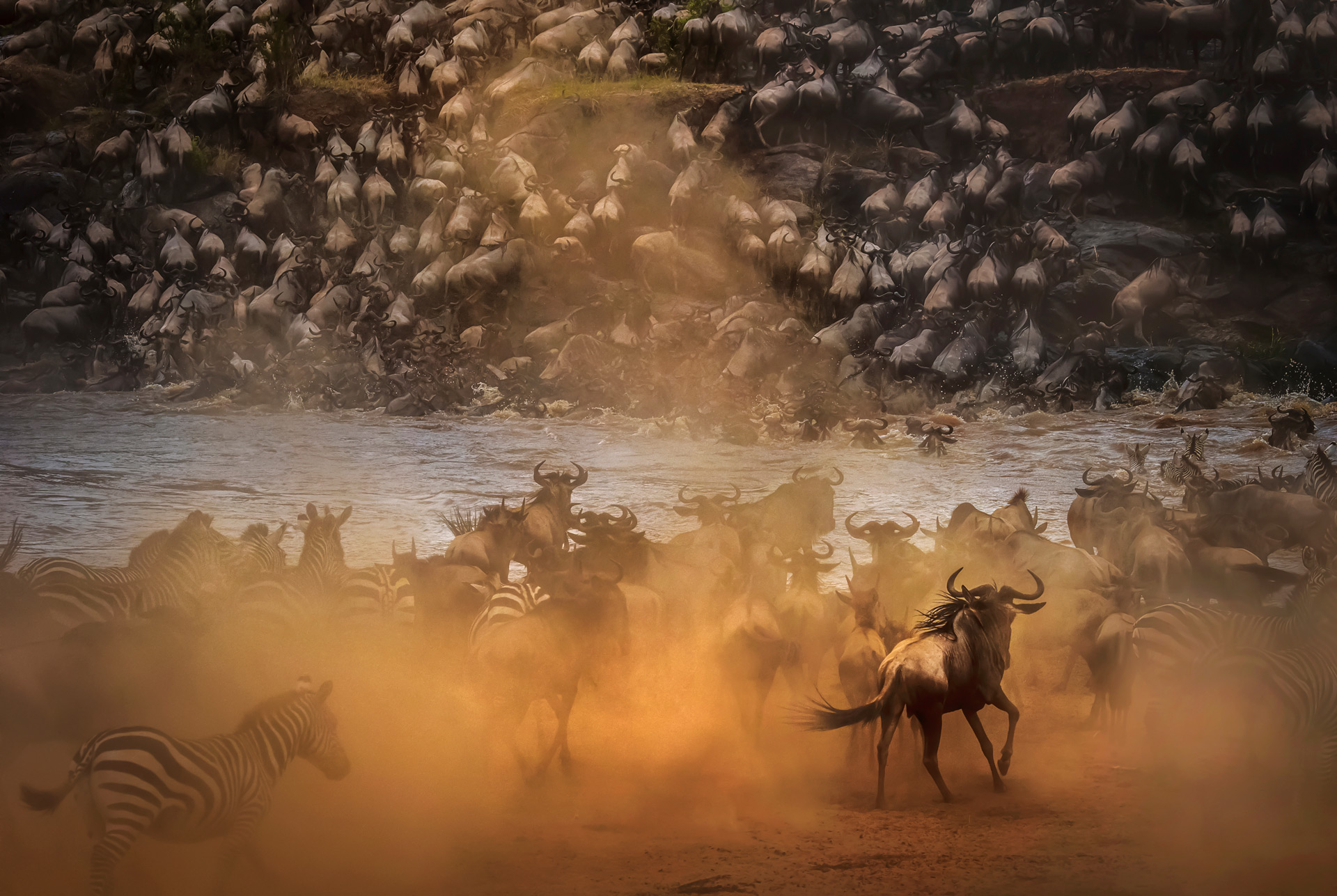The wildebeest migration is a magical experience that tourists most seek. Millions of animals move across the Serengeti to the Mara ecosystem. The ever-moving circulations of wildebeest are in search of water and grazing fields.
The movement takes part in the Serengeti southern region of Tanzania. The calving season takes place near the Ngorongoro conservation. The animals travel throughout the Serengeti clockwise and then journey to Masai Mara in Kenya. The most incredible show on earth is flabbergasting numbers; thousands of lions, zebras, hyenas, gazelle, wild dogs, cheetah, leopard, crocks, and millions of wildebeests can be witnessed.
The animal’s number replenishes during the calving season sustaining the Serengeti-Mara circle of life. This is the largest herd movement on earth. It stretches up to 1000 animals per square kilometer. You can view the migration from space.
The dramatic event is thrilling as predators hunt their prey. They seize the young calves, and the lion prides snatches the slow mammals. On the other hand, the mighty beasts are taken down by ferocious crocodiles. The animal’s survival instinct guides them throughout their journey. Only the strongest and tactical ones survive.
See also: Witness Kenya and Tanzania wildebeest migration
 Wildebeest Migration From December To March
Wildebeest Migration From December To March
Tourists that travel during these months enjoy a spectacular game viewing. The herds move across the Serengeti eastern region to Ngorongoro Conservation Area. The calves grow up strong as the verdant plain grass has rich nutrients. The open volcanic plains host the wildebeest in the rainy season.
Despite the migratory circuit not having a start or ending point, we can view the birthing stage as the beginning of migration. There are thousands of calves and several deaths. Within two to three weeks, you can witness close to 400,000 born. Every day about 8,000 calves are born.
The young calves are endangered as predators eye them. Tourists can enjoy the striking view of the big cats and newborn animals in the southern part of Serengeti. From Lake Ndutu, you can admire the swapping scenery of the plains.
Wildebeest Migration From April To May
It is baffling how the animals know the best direction to follow. However, it is presumed their response to the weather dominates the movement. They travel in search of new grass, guided by the rain. Experts believe animals can notice rainfall more than 50km away. They allegedly respond to thunderstorms and lightning in the distance. The migration happens throughout the year.
During Feb and March the animals give birth and around April their movement will be seen at the northwest part of Serengeti. The grass is verdant in the central region. You can view the antelopes, and zebras. The three categories of migraine grazers have various eating habits. One of them feasts on the tallest top grass, the second group eats the medium height grass, while the third group eats away what is left.
The Serengeti plains grass has rich calcium and high protein content. The southern part is eaten up and a volt of vultures follow the animals to the Western Corridor. They feast on the tired and injured mammals. The animals have to cross the Grumeti River whereby the hungry fierce crocodile awaits.
They grow up to 6 meter long and snatch the fat animals fast and stealthy. By the beginning of May the wildebeest assembled at the Moru Kopjes. While the end of the month marks the start of the mating season. The game viewing is epic as the region has a low number of tourists.
Related: Great Wildebeest Migration Monthly Guide
Wildebeest Migration In June
The dry season approaches in June. There is a massive number of wildebeest in the Western region of Serengeti. The rest of the animals are at the southern embankment of Grumeti River. All the animals must close over. This is a daunting task and only the strongest survive. The animals are moving to the northern side of Serengeti.
The wildebeest further travel to the north region approaching the unfenced Kenya-Tanzania border. Yet again the animals must cross the Mara River. Here you will find enormous starving crocodiles ready to feast on the fleeing hordes. The risky river crossing is controversially the most stirring wildlife event on the planet.
The season is not serene as the male attempt to mark their territory. The animals will move to the west side. Here they will further divide themselves as some head directly north while the rest of the crowd move to the northeast.
Wildebeest Migration From July To October
Tourists can watch the thrilling river crossing event from the Talek and Mara rivers. These two sources are the incredible hub of the whole drama. During August the majority of the animals successfully arrived and settled in Mara. They continue to spread out in the northern region of Masai Mara.
On the other hand the animals that cannot cross over remain at Serengeti northern side. This usually happens when the wildlife are confused or panic when the river is in full flow. Some are scared of the carnivorous both in the water and on land. The predators patrol the riverside around the clock.
The animals will be present in Masai Mara from July, August, Sep, October and sometime up to November. The land becomes dry as the animals have eaten out most of the grass. From September to October the mass moves to the eastern part. The mammals are getting ready to head back to their breeding land which is flourishing and profuse. The wildebeest follow the Lobo area and Western Loliondo route to Serengeti National Park.
See: Wildebeest Calving Safari Season
Wildebeest Migration In November
East Africa receives short rainfall at the end of October and the beginning of November. The animals will be approaching the eastern region of Serengeti far from the Namiri Plains. The region is famous for epic cheetah sightings. As December approaches the animals are all over the eastern and southern region.
Serengeti plains grass growth varies from one region to the other. At the far southern edge the grass is profuse. The animals will be here for a while before the cycle continues to the calving season.
 What is the main reason for The Migration Of The Wildebeest
What is the main reason for The Migration Of The Wildebeest
The herds of animals move from Serengeti to Masai Mara. The wildebeests are following the rain and areas that have abundant food. The calving season marks the start of the migration. The animals will move to various regions of Serengeti before heading to Mara.
See Also: Everything you should know about Hot Air Balloon Safari in Serengeti
What guides the Wildebeest while migrating
You may wonder how the animals know where to move. Scientifically there is no theory that shows the technique being used by the wildebeest. However, some believe the animals are following the burying weather. They move in profuse regions with abundant food and water.
Facts about the Wildebeest Migration
The spectacular Great Wildebeest Migration has over 2 millions animals in movement. Thousands of zebras, gazelles, and a million of wildebeests. Everyday the mammals give birth to about 8000 calves. In the calving season there are over 500,000 newborn.
The wildebeest migration is the greatest show in the world. The astounding natural show is a fascinating experience. It is also full of ranging emotions, heartache, thrill, anticipation, inspiration and much more. The animals travel in groups for survival and to reproduce more younglings. This is not an easy adventure as the wildlife have to be cautious of the predators on land and in water.
You might also like: Reasons why you should go to Kenya for your wildebeest Migration Safari

